Ho Chi Minh President, also known as Uncle Ho (1890 - 1969), was a revolutionary and a founder of Communist Party of Vietnam. He was also one of Vietnamese leaders in the struggle for independence and freedom of the country. On September 02, 1945, he read the Vietnamese Declarations of Independence in front of thousands people in Ba Dinh Square announcing the birth of the Democratic Republic of Vietnam. Being widely admired and revered by not only Vietnamese people, but also people around the world, Uncle Ho left profound grieves when he passed. Many monuments and historical relics were built to commemorate the merits of this President such as Ho Chi Minh Mausoleum, Ho Chi Minh Museum, Ba Dinh Square, Presidential Palace Hanoi, Ho Chi Minh's Stilt House. These five monuments are located in a unified cluster of historic relics in Ba Dinh district, Hanoi capital.
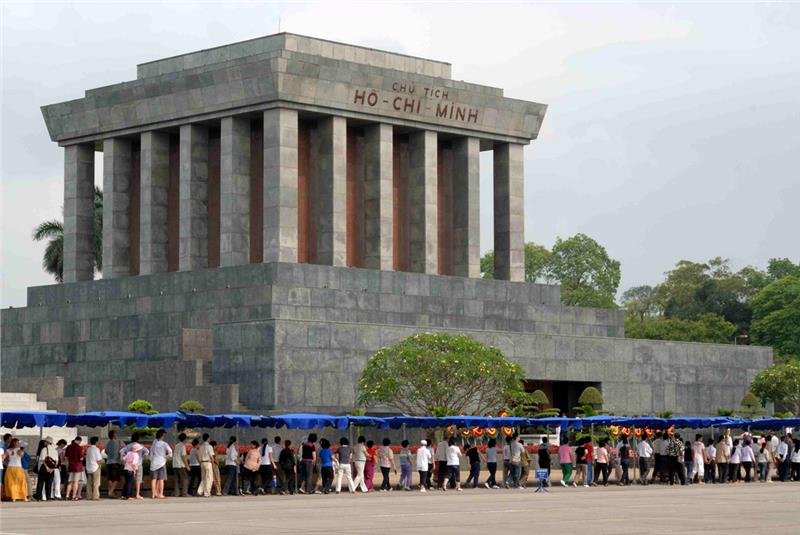
Ho Chi Minh Mausoleum is situated in Hung Vuong Street, Ba Dinh district. The Mausoleum was officially started building on September 2, 1973 and inaugurated on August 29, 1975. The architecture of the Mausoleum is the combination between Lenin Mausoleum's architecture and distinct architectural elements of Vietnam. The building materials for construction were brought from different places in Vietnam including sands taken from Kim Boi stream (Hoa Binh province), boulders from streams in Son Duong, Chiem Hoa, Ngoi Thia, Tuyen Quang, stones from Thanh Hoa, Yen Bai, etc.
Ho Chi Minh Mausoleum consists of three layers with 21.6 meters high and 41.2 meter wide. The mausoleum's portico has the words "Chủ tịch Hồ Chí Minh" (President Ho Chi Minh) made from dark red jade stone of Cao Bang province. The lobby was tiled by red marble, which is the background of the words "Không có gì quý hơn độc lập tự do" (Nothing is more precious than Independence and Freedom), and the signature of Ho Chi Minh president. In the middle of the Mausoleum, the embalmed body of Ho Chi Minh is preserved in a glass coffin protected by four military honor guards.
With regard to landscapes surrounding the Mausoleum, there are two wildflowers in two sides of the front door. In the rear and the back of the Mausoleum, 79 cycas revoluta were grown symbolizing for 79 years in the life of Uncle Ho. In the south and the north of the Mausoleum, there are two ranges of bamboo, which are a symbol of Vietnam. In the front of the Mausoleum is Ba Dinh Square.
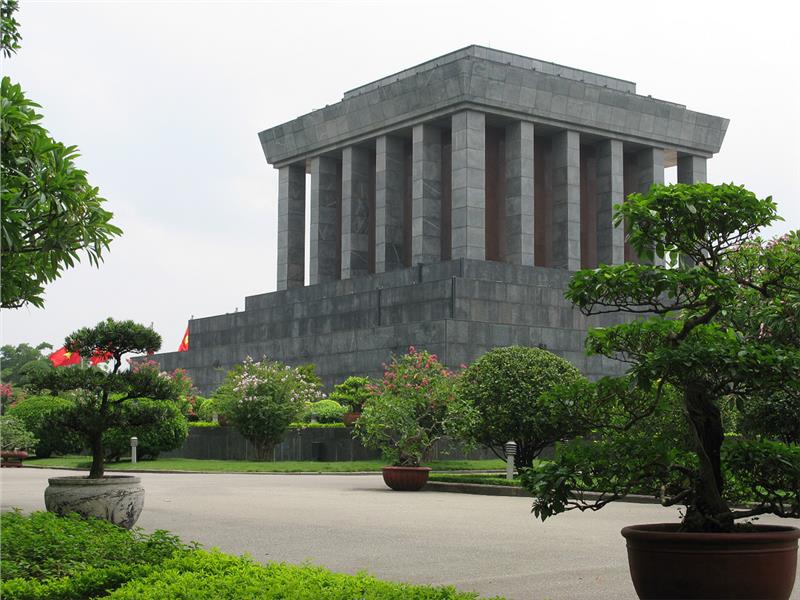
Ho Chi Minh Mausoleum opens in all mornings except from Monday and Friday, from 8.am to 11.am in cold season and from 7.30 am to 10.30 am in hot season. Sometimes (often in October and November), the Mausoleum will be closed for restoration and preservation. Currently, the Mausoleum does not require entrance fee, however, visitors must comply some requirements. Specifically, visitors have to keep silent and walk in two lines. Smoking, drinking, eating, taking photographs, and taping video are not permitted anywhere inside the Mausoleum. Legs must be covered (no shorts or miniskirts).
Ho Chi Minh Mausoleum is a meaningful cultural work of Vietnam. For each Vietnamese citizen, visiting the Mausoleum is an emotional need to express the gratitude to the great leader of the country. As estimated, until 2007, there were over 33 million turns visiting the Mausoleum including both domestic and foreign visitors. According to Vietnam National Administration of Tourism, Ho Chi Minh Mausoleum is one of Hanoi attractions cannot ignore of nearly 100% international tourists when setting foot in Hanoi. Besides, Ho Chi Minh Mausoleum, Ho Chi Minh Museum is also a place where tourists can visit, listen touching stories, and have an overview about Ho Chi Minh's life and Vietnam Revolution.

Ho Chi Minh Museum is situated in Doi Can Street, Ba Dinh district. The Museum was launched on May 19, 1990 on the occasion of solemnly celebrating the 100th birthday of Uncle Ho. The monument aims to express the deep gratitude of Vietnamese people to the great contributions of their former President. Ho Chi Minh Museum is the largest museum in Vietnam. The Museum mainly focuses on displaying artifacts and documents about Ho Chi Minh's life and career.
The Museum was designed by a Russia designer, Garon Ixacovich. It has three floors with nearly 20 meters high and 30 meters long. It has the shape of an ethereal white lotus flower, which are reminiscent of Sen Village (Lotus Village), Ho Chi Minh's hometown. Next to the building, there is an artificial lake with a diameter of 18m making the scenes surrounding the Museum more vibrant.

There are three main contents displayed in Ho Chi Minh Museum. The opening part exhibits life and revolutionary career of Uncle Ho and implementation of Ho Chi Minh's Testament by Vietnamese people. The second part is the introduction of lives, battle, and victory of Vietnamese people in wars. The last one is the introduction of some events in the world's history that made a great impact on life and career of Ho Chi Minh and Vietnam revolution.
Ho Chi Minh Museum is a research center introducing about the life of a great man, who devoted all his life to the cause of national liberation and human liberation. Since its inauguration, the number of visitors has been growing significantly. Especially, on weekends and holidays, there are great deal of people visiting the Museum. In some days, the number reached 2,000 people per day. It shows the fact that the Museum is not only an architecture having the national stature but also the crystallization between the cultural traditions and the deep gratitude to Ho Chi Minh President. The Museum opens at 8.00 am in all morning apart from Monday and Friday.
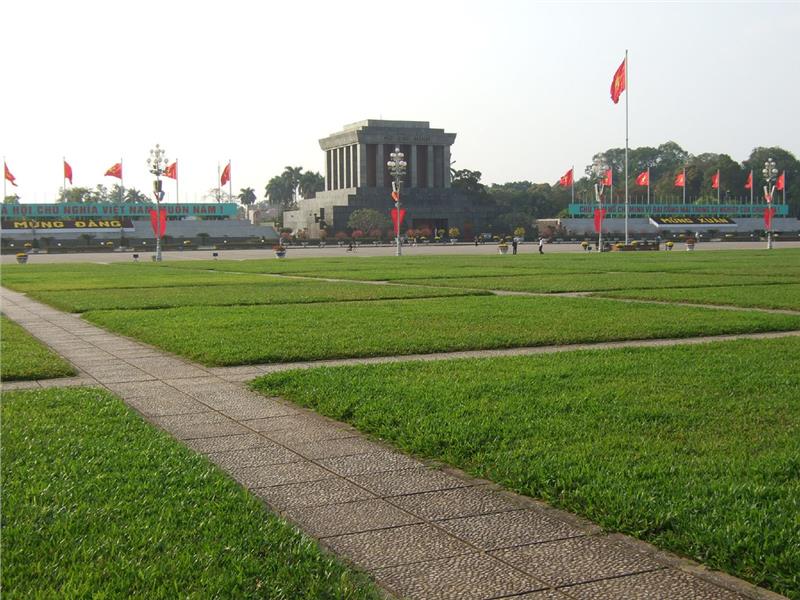
Ba Dinh Square is the largest square in Vietnam located on Hung Vuong Street and in front of Ho Chi Minh Mausoleum. Therefore, tourists visiting Ho Chi Minh Mausoleum also can admire Ba Dinh Square as well. The Square is a place where many historical milestone of Vietnam happened. Especially, on September 02, 1945, in this place, Ho Chi Minh President read the Proclamation of Independence of the Democratic Republic of Vietnam. After that day, Ba Dinh Square is widely recognized as the birthplace of a new Vietnam. Except from this event, the Square also witnessed other highlighted event of the country such as a solemn rally of the Central Committee of Vietnam Labour and Government of the Democratic Republic of Vietnam came back to Hanoi capital on January 1, 1955, a rally celebrating national reunification on September 2, 1975, parade celebrating Millennial Anniversary of Hanoi in 2010. Nowadays, the Square has the length of 320m and the width of 100m. In the middle of the Square, there is a flagpole with 25 meters high.
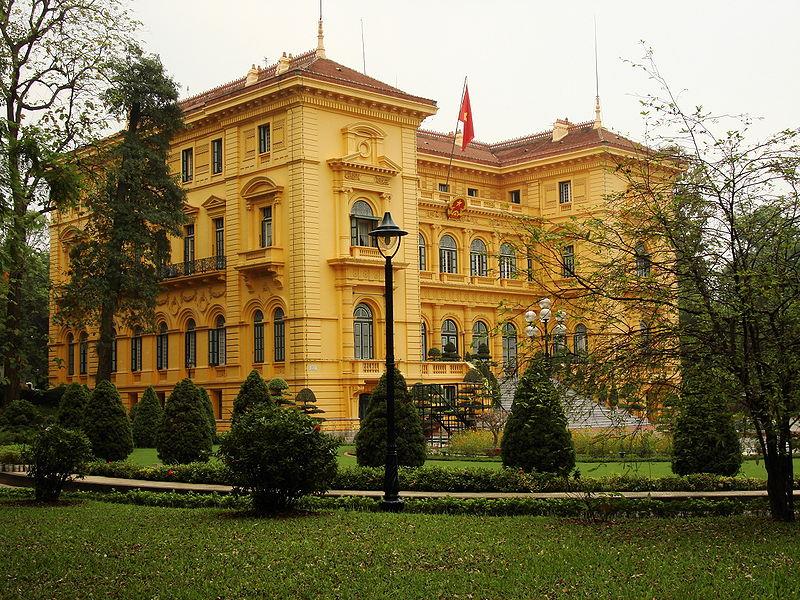
Presidential Palace Hanoi is a place where Ho Chi Minh President used to live and work from December 1954 to September 1969. This place is ranked in the list of 23 special national monument of the country. In Presidential Palace, Ho Chi Minh President met many delegations who are the representatives of political parties, workers, peasants, intellectuals, etc. After he passed away in 1969, the Palace became a historic relic. In this historic relic, besides visiting the Presidential Palace, tourists also have a chance to visit a fishpond, orchards, and Ho Chi Minh's Stilt House. These places have become an important monument related to 15 years living and working of Ho Chi Minh.
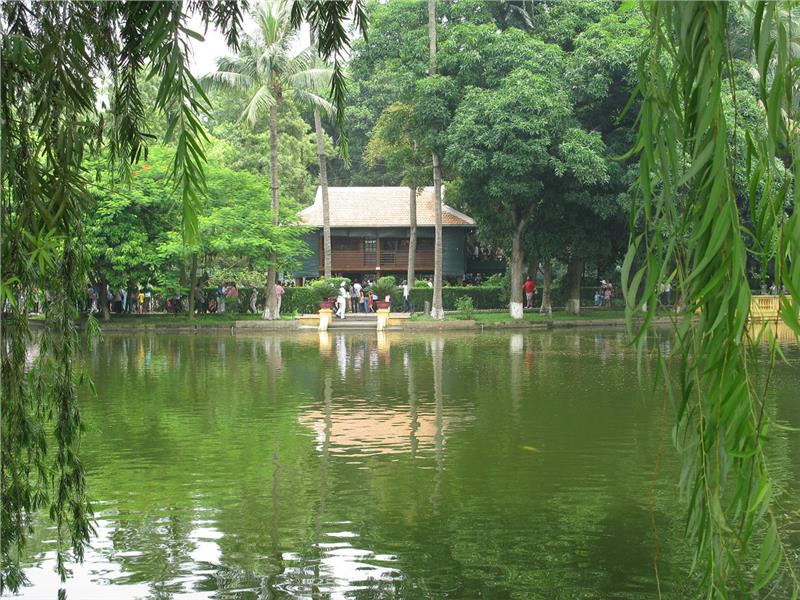
With the virtues of simplicity and loving nature, Uncle Ho did not like living and working in the Presidential Palace. Presidential Palace is only used for the reception activities or diplomatic rituals. In May 1958, according to the inspiration of Uncle Ho, officers and soldiers built a Stilt House in the garden of Presidential Palace. The House was inaugurated on May 17, 1958 in order to celebrate the birthday of Uncle Ho. It is located next to the fishpond surrounded by orchards having many rare plants from different places in the country. The Stilt House has two floors. The upstairs has two rooms where Uncle Ho worked and lived. The downstairs was a reception desk. The Stilt House is surrounded by idyllically natural landscapes including a hibiscus hedge, a fishpond, and fruit trees and so on.
Known as the most talented leader of Vietnam, Ho Chi Minh was chosen as one of 100 most influenced people in the world in the 20th by Times Magazine. The unified cluster of historic relics in Ba Dinh district is one of ideal attractions in Hanoi for tourists who love know more about Ho Chi Minh life and career in particular and Vietnam wars in general.
